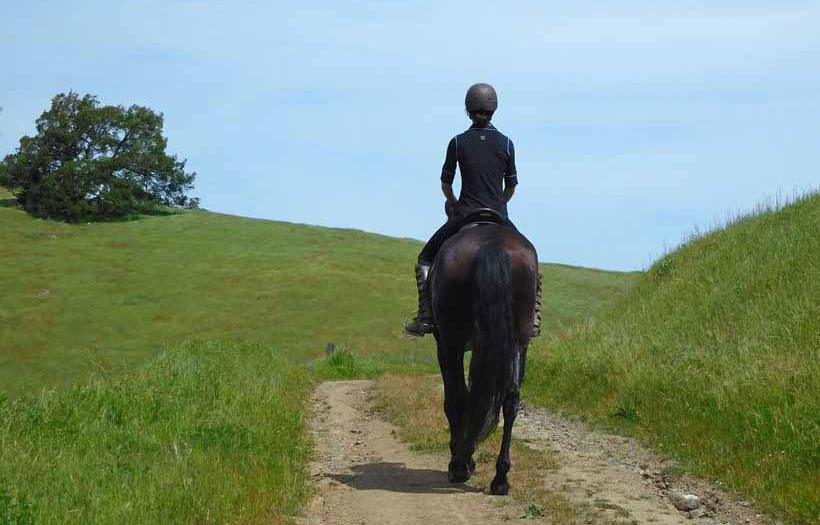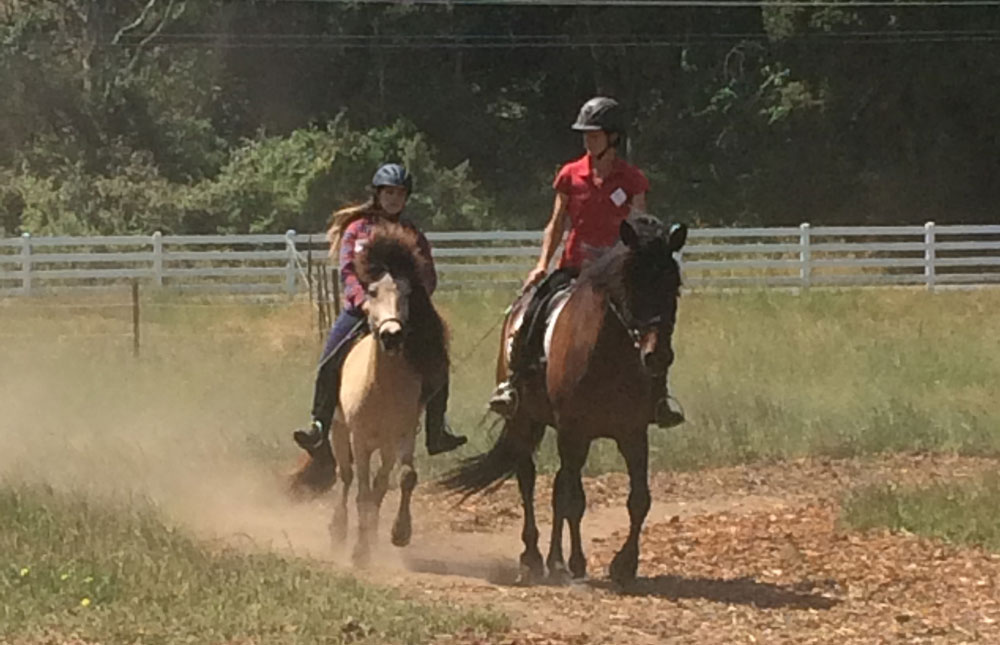
In fact, the top five most important skills for a trail horse are also what I believe to be the most critical skills of an arena horse. No matter where you prefer to ride, you won’t get very far without solid mastery of these. With the following five skills, you will be a lot safer and have more fun.
1. Horse moves off leg promptly and softly. This is an absolute must. When a rider closes her leg against the horse’s ribcage with less than one pound of pressure, the horse must yield his body sideways instantly. Most arena riders strive for this, especially given that this responsiveness determines the quality of lateral exercises. But many times our horses’ responses are a lot less tuned than we realize. This becomes apparent when we get out on the trail and we need a lightning quick response as a car or loose dog comes towards us, a tree branch blocks our path, or the terrain gets dodgy and you need to make a quick course correction.
2. A reliable WHOA. In dressage, you’ll lose a few points in every test without a square, motionless halt. Once outside the confines of your arena, you stand to lose more than just a few points without an obedient standstill. It becomes apparent what a safety issue it is when a horse won’t stand quietly for as long as a rider needs. Achieving this calm steady halt is equally important from a blazing speed as well as from a casual meander. To practice this, I have arena riders ride around the arena at fast speeds and then stop sharply when I ask. Than I ask them to ride again at speed, but this time transition gradually to a stop by shifting downward through slower gears first. I call these variations a hard stop versus a soft stop. They prove the horse can keep his mind calm no matter how his physical energy varies.
3. Horse pays attention to rider, always. On the trail, it can be frightening when your horse becomes a lot more interested in something besides you (flapping tarps, running deer, bicycles). When horses spend a lot of time in the arena, they can get in a rut of performing habitually rather than with moment-to-moment focus on the rider. Then when they hit the trails these horses pay attention to everything around them except their rider. This leads to behaviors like herd-bound anxiety, spooking, excitability. The horse needs to have his thoughts on you at all times whether you’re on the ground or in the saddle. Find ways to confirm this while riding out: practice transitions between gaits; avoid long stretches of riding single file; practice lateral movements.

4. Straightness. Without this, the horse is in charge. An old German dressage master had a quote that the horse had to “stay between the rails,” meaning he remained aligned where your legs told him, not bulging sideways or traveling with a kink in his body. This physical symmetry and balance always benefits from further refinement, and one of the best places to confirm it is on trails. Particularly when traveling down hills or through spooky areas, it is crucial that your horse remains straight on your line of travel instead of ping-ponging around. Remember that you are in control of where his feet go whether you’re riding circles in the arena or traversing a gulley. Do not let his haunches drift sideways or his front end ‘lean’ off your line of travel.
5. A reliable, responsive GO. Dressage sessions often include a period of ensuring the horse is “in front of the rider’s leg,” which basically means he surges definitively forward as soon as he is asked. On the trail, this mastery can save you from unpleasant situations. Certain scenarios turn bad quickly if your horse is sluggish about his “go” response. Do everyone a favor and verify when you step on the gas pedal, you get an immediate reaction.
Author, speaker, and trainer Jec Aristotle Ballou teaches widely as a horse fitness specialist. A frequent presenter at national expos, she helps riders of all
disciplines cross-train with dressage. Her books are sold widely both
nationally and internationally. Visit her website at www.JecBallou.com.






Wow—-we just had this conversation at the barn–we do not just sit there–the horse does not do all the work–many trail riders ride in “show form”—it’s safer, causes lass fatigue in the horse, and promotes balance and harmony. Nice article–do-able exercises.
[…] Bron: Horse-illustrated […]